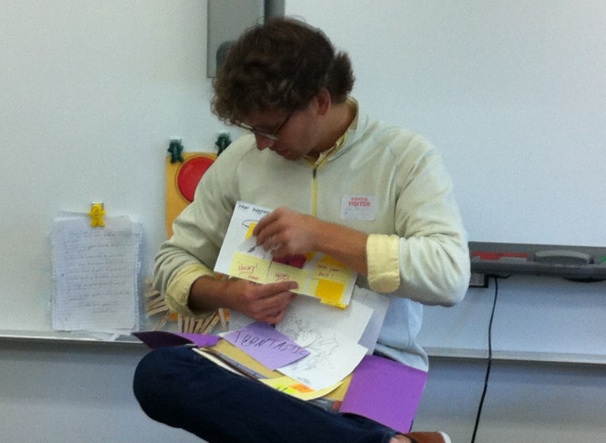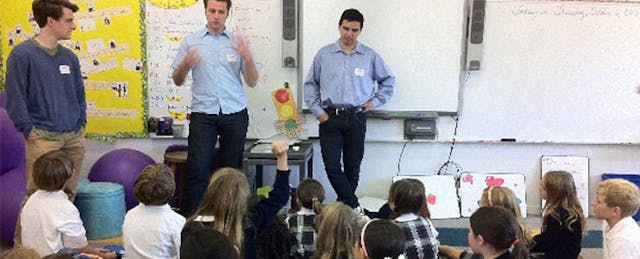I have always used field trips to enrich my students experiences and connect their learning to the real world. When an edtech entrepreneur asked me if he could visit my classroom and share his work with my students, I realized I could “flip” the field trip--and bring an intriguing experience to my students. What I didn’t expect was what we would all learn in the process.
Here’s what happened: In the fall of 2011 after I had commented on the Motion Math blog, company cofounder, Jacob Klein, reached out and asked if my students would test a game still in the works (not even named).
Not only did my excited 4th graders try out the game, but they were thrilled to meet the developers. After a brief introduction, the developers met with each student to test out the game and listen to their feedback. They even invited them to “draw the next level” of the game and suggest possible names for the app.(It eventually became Hungry Fish).
The students were so excited, they didn't even want to go to lunch!
My goal for this particular visit was multi-faceted. I wanted students to see the innovators in our community and be inspired by their hard work. Equally powerful was the chance for students to have a voice in contributing ideas to products created for them. Finally, I regularly seek ways to inspire kids to work hard to follow their dreams and passions. These guys were great role models, emphasizing the importance of learning from mistakes and working hard.
Parent comments to my blog post highlighting the experience were encouraging too!
Steve B. on October 7, 2011 at 3:39 pm said:
This is simply awesome! Ca** was super excited about this opportunity, and I think it’s fantastic that our kids are exposed to smart, young people trying to make things (in this case, software) that will make education a better experience. I also love that our kids realize that their opinions are important, and that 1 person can influence something that might impact many, many people.
Thank you, Mrs. Young.
And finally, we got the feedback from Jacob that the product was now live with a comment on our class blog.
Jacob Klein on February 23, 2012 at 12:24 pm said:
Thanks so much Ms. Young for hosting us in your classroom. We learned a lot, and here’s the final product--our game Motion Math: Hungry Fish – http://bit.ly/hungryfish.
We hope to visit again soon!
Best,
Jacob, Motion Math
A couple months later, in May 2012, my students became part of a study for Toontastic and met Andy Russell, CEO and co-founder when he came to observe them using the app. After the observations, we invited Andy to share some of his experiences with us.

Andy taught how to create an app using his product, Toontastic, as an example. He went through the various steps, from paper prototyping to Keynote clickthroughs, to show how to test ideas when building a game.
Andy’s message definitely aligned with the “growth mindset” we worked on in class:
- Students learned that projects are never really done: iteration is revision; revision is a good thing. (I would have paid him to say this, actually, as you can imagine how critical this message is to fourth grade writers!)
- You learn from your audience. Be open to feedback. Respond to it.
- Great products have many, many changes made to them.
“It's never too early to develop your ideas and turn them into something special,” Andy advised the class. Kids don't have to wait until they learn college-level coding to develop and refine their big ideas. As much as 70% of the process of developing an app--or any software can be mapped out using paper prototyping. Andy even showed us the preliminary paper prototypes of Toontastic and how he tested his ideas with his early audience of beta testers.
It’s one thing to tell your students to work hard, yet another for them to hear it from creative professionals they admire.
I was hooked on the power of inviting innovative teams into my classroom so I was thrilled to have another opportunity. A year later during the fall of 2012, Motion Math’s Jacob Klein again asked if my students would like to try out the latest in-development Motion Math app. (It hadn’t even hit the app store yet.) I was excited that “Questionville” (later called Questimate) would give my new fourth graders a chance to beta test, too.
Jacob asked me to not share anything about my association with him or even that the game was developed by MotionMath. He wanted students to be completely honest, unswayed by my opinions or by experience they might have had with other MotionMath games.
My students jumped in eagerly, trying out the game with a partner then furiously scribbling answers to my questions. I found it helpful to ask a few structured questions to guide them in writing quality feedback. Saying, “ I like it,” or “It’s fun” were not satisfactory replies!
Here were the students’ comments after their initial trial of the app.
- They liked the idea of creating their own questions.
- They didn’t like when it crashed. Surprise!
- They liked that the questions were specific.
- Some other students didn’t like the fact that it was hard to get the right answer when it was too specific.
Students were thrilled to hear their comments were going straight to the developers. They also responded well when I prompted them to think more deeply and critically. Comments such as “It’s fun,” were transformed into “It’s fun to compete with my friend who is much better at estimating weight!”
For months and months, students asked me if they could use this app with friends during rainy day recess. They also reported that they continued to use it at home with their family. For an app that promotes curiosity, critical thinking, and problem solving, what could be better than the testimonial of students choosing to play it on their own time?
When we consider that students are the end users, and are ultimately the ones that benefit from these technology tools, we need to include their voices in the critical feedback loop.
Not only did we learn, but our visitors grew their knowledge as well.
Here are a few tips from Jacob Klein about involving students in beta testing.
"Going into classrooms is revelatory--we always discover something new about our learning games and about the minds of students. It's also extremely motivating to see a kid learning from software you've created!
After a few years of regular classroom visits, we've realized that to test for playability, you have to be very quiet and not give help; to test for engagement it's best to go to afterschool or camps or other really fun locations; and to test for learning, you have to ask follow up questions: why did you choose that answer? What do you think the game is teaching?"
Most importantly, my students realized that their voice matters, and that creating products requires making mistakes, perseverance, and determination. Some even changed their goals for the future and began planning creative projects after meeting these inspiring teams. I can’t imagine a better way for those ideas to come to life for my students than these “flipped” field trips.


